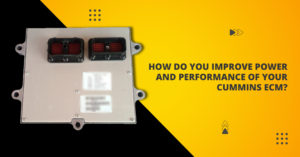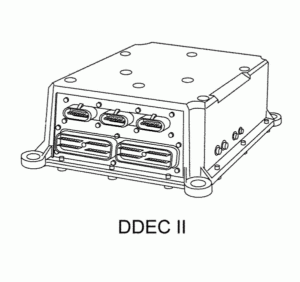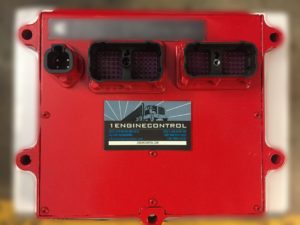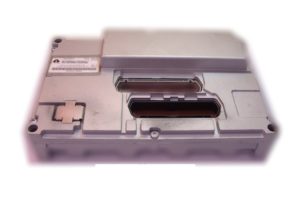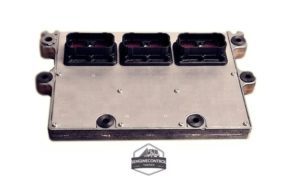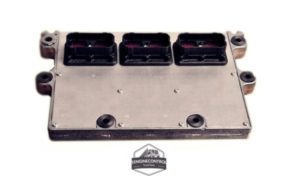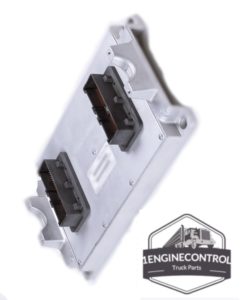How to determine if you have a bad Ecm. From testing CUMMINS ECM, CATERPILLAR ECM, DETROIT ECM,INTERNATIONAL ECM 1ENGINECONTROL has the right solution to diagnose a Bad or Good Ecm.
Diesel Ecm Engine Diagnstics.
Before doing complicated things lets go back to the basics. Real technicians that are properly trained and cerfiied by Cummins and Caterpillar though Higher Level Programs can help you out here at 1Enginecontrol. Just ask for John. (Juan Estrada CEO)
All that was needed to get an old diesel engine started was the proper amount of heat in the combustion chamber and the proper amount of combustible fuel, injected into the combustion chamber at the proper time. It is no different today with electronic diesels. By keeping those basics in mind, a seemingly hard no start problem can be simplified.
Looking at diesel diagnosis, let’s discuss the two most basic needs of diesel engine operation: proper combustion chamber heat and the proper amount of fuel injected at the proper time.
The Need for Heat
When asked what makes heat in the combustion chamber, most techs will reply “proper compression” or “proper glow plug operation.” These are great answers, but when I’m faced with this question, I always start with the proper cranking speed. I might move on to the compression and proper glow plug operation, but without the proper cranking speed, the engine compression is a moot point.
Most diesel engines need a minimum cranking speed of 150 rpm. If the starting system is not capable of turning the engine fast enough, do some testing and find out why. The technician might need to start with an inspection of the batteries, which will include a load test of the batteries, some voltage drop testing of the negative and positive sides of the starter circuits and maybe a current draw test on the starter. If all these tests pass, then check for something binding inside of the starter or the engine. Until the engine will crank fast enough, any other testing is a waste of valuable time.
Stop and think about engine compression. In a combustion chamber, there are only four places for the compression to escape: through a leak in the combustion chamber (cracked head or leaking head gasket), through a leaking intake valve, through a leaking exhaust valve or through a leak in a piston or piston rings. I find it easier to find where the compression went and in these cases, it is easy to check for pressure pulses in the intake manifold, the exhaust pipe, the engine crank case or in the engine cooling system.
This process will require a labscope and a FirstLook sensor, but in most cases the process will be quicker and more reliable than having to remove parts and engine components in an attempt to gain access to a place to get an actual compression reading.
The Need for Proper Fuel Injection
After the proper compression has been verified, the technician needs to verify proper fuel injection. Here is where things start getting a little complicated. Back in the day of the mechanical fuel injection systems, it was easy to loosen a high pressure fuel injection line and see if fuel was being delivered to the fuel injectors. In the world of today, this is a little harder, if not downright impossible.
With the advent of the electronic diesel fuel injection system, a scan tool and scan data will be your friend. If you are working on a HEUI (Hydraulically actuated, Electronically controlled, Unit Injector) system, you have PIDS (parameter identification) for several different things. Specifically the Injector Control Pressure (ICP), Injector Pressure Regulator (IPR) and fuel injector pulse width PIDs.
A tip on using scan data: When watching the ICP, don’t rely on the pressure ICP pressure PID, instead use the ICP volts. The reason is simple. On a long crank/no start, the Powertrain Control Module (PCM) can use a substitute number for pressure. The pressure voltage, though, is always correct. If you are working on a common rail diesel fuel system, the injector rail pressure PID is the telltale PID on fuel pressure. All common rail engines have a pressure sensor in the high pressure rail. If this sensor is showing the proper amount of pressure, you can be assured there is pressure in the rail. But you have to ask, “Is this pressure air, combustible fuel or some other liquid?” Any time you are dealing with a cranks/no start, it is very important that you verify fuel quality. There is nothing worse than working for an hour or so before finding out the fuel tank is full of gasoline or some other liquid that will not combust in the combustion chamber.
Once the proper compression and fuel pressure have been verified with a scan tool and the engine still will not start, the next step is to determine if the fuel is being injected into the combustion chamber. Over the years, I have seen many no start problems caused by stuck fuel injectors. This year alone, I have had three vehicles that needed a set of new injectors to resolve a no start problem.
A good way to verify Injector is to watch the tail pipe while the engine is being cranked. If fuel is being injected into the combustion chamber, some fuel will be blown out the tail pipe. Now, on vehicles with a catalytic converter and a Diesel Particulate Filter (DPF) this might not work, because the fuel vapor can get lost in all the exhaust components. As a last resort, it might be a good thing to pull out a glow plug (if the engine has glow plugs) and give the engine a crank. If fuel is being injected into the combustion chamber, there will be a nice cloud of atomized fuel being blown out into the air.
I am a little reluctant to grab a can of starting fluid and start spraying it into the air intake. Over the years, I have seen a few engines badly damaged from this quick start method. If the engine has the proper compression, the proper cranking speed and the proper amount of fuel injected at the proper time, the engine will start.
Start with the Fuel System Basics
Before a technician can start on any diagnostic problem, he or she needs to be aware of how the system works. Back in the day, this was simple since there were only three different kinds of fuel systems, but today we have common rail, hydraulic unit electrical injector (HEUI), some PLN systems and a few different versions of unit injection. Before you start on a diagnostic problem, I would encourage you to get familiar with the fuel system and your scan tool. The bidirectional tests and controls from the scan tool will be where you do most of your testing and problem analysis.
On to the Application
The problem vehicle in the bay is a 2005 Ford F550. Checking the VIN found it was powered by a 6.0L diesel engine with an automatic transmission. The odometer shows it has traveled 98,000 miles. The owner said the engine had died when rounding a left-hand corner, but the engine restarted and had been driven back to their business. The next time the truck was needed, the engine would not start.
Because any diagnostic problem starts out with information gathering (clues to the mystery), I want to know if there are any Diagnostic Trouble Codes (DTCs) stored in memory. In this case, there is only one DTC stored in memory; a DTC P2623 is set for a circuit problem in the Injector Pressure Regulator (IPR) circuit. Some things that come to mind that could set this code would be such a simple thing as the IPR not being plugged in, but it also could be an open circuit in the IPR coil. Retrieving this code first saves a lot of diagnostic time, since I can rule out a lot of other things that can cause a no start.
If this engine were a 7.3, it would be easy to just do a visual of the IPR and see if the plug was in its socket but in this case, the IPR is buried down under the turbocharger, covered by the coolant degas bottle and the Fuel Injector Control Module (FICM).
Before you start removing parts and poking around for a problem, it is always a good idea to spend a few minutes with the scan tool and gather some data. The stored code is a circuit code, but how much time could be wasted if the problem were something else besides the circuit problem? One reason I suggest some scan tool testing is because there are a lot of parts that need to be removed to gain access to the troublesome part, and most of these parts must be installed before the engine can be started.
One clue that is sticking in my mind is the engine stall when rounding a left-hand corner. Because this engine is dependent on proper oil pressure to make the fuel injectors work, it is a must that the technician start by checking the engine oil level. In this case, the oil was at the top mark of the dipstick. The next step is to hook up a scan tool and select some important PIDs applicable to the injection system. Selecting the three FICM voltages, Engine RPM, the ICP voltage and IPR percentage will give a good indication of the hydraulic control of the fuel injectors. By using these data PIDs, the technician can also get a good indication if fuel is being injected into the combustion chamber or if the combustion chambers are hot enough to start the engine.
The scan data is showing the ICP voltage will only make it to 0.67 volt. Keep in mind that this vehicle has been outside in 15 degree Fahrenheit weather all night. The oil is quite thick, so the cranking rpm is a little slow at only 138 rpm, but the key to this problem is the low ICP voltage. The HEUI injection system needs a minimum pressure of 0.8 volt of ICP before the fuel injectors will be pulsed. In this case, this ICP voltage is also a great indicator the IPR is stuck open. The IPR is a pulse width modulated pressure regulator that normally is open. Without an electrical connection, this pressure regulator will never close to build the proper oil pressure to operate the injectors. The next step in this diagnostic process is to remove some parts to verify an electrical problem.
With the degas bottle, air filter and FICM removed, the IPR can be seen and touched, but the plug and wire are buried under the solenoid and the heat shield that protects these electrical parts from the heat of the exhaust pipes and the turbocharger. A look down in the hole with a bore scope found the suspected plug not properly seated in its socket.
With the IPR control wire plug properly installed, the FICM was plugged in. The first time the starter turned the engine, the engine fired right up and ran smooth.
After any repair, the vehicle needs to be driven until it reaches its operating temperature and the engine data checked again with the scan tool. In this case, since this no start problem was caused by lack of ICP, I am interested in the high pressure oil that operates the fuel injectors. Selecting the RPM, ICP, IPR percentage and Engine Coolant Temperature (ECT) will give the information needed to verify the high-pressure oil problem is fixed.
The best time to use the scan data to snoop out a high pressure oil leak is when the engine oil is hot and the engine is idling. In this case the IPR percentage is showing 23 percent at hot idle. When the engine was shut off and restarted, it exhibited a quick start and the IPR percentage is still at 23 percent, so I can rest assured there are no high pressure leaks in this system. This truck is ready to ship and put back to work.
For more info please email us or Contact Us regarding your next purchase for a Cummins Ecm Caterpillar Ecm or A Ecm Repair on all Heavy Equiptment.

